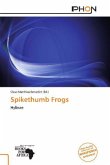Please note that the content of this book primarily consists of articles available from Wikipedia or other free sources online. Frogs have been used in animal tests throughout the history of biomedical science. Eighteenth-century biologist Luigi Galvani discovered the link between electricity and the nervous system through studying frogs. The African clawed frog or platanna, Xenopus laevis, was first widely used in laboratories in pregnancy assays in the first half of the 20th century. When human chorionic gonadotropin, a hormone found in substantial quantities in the urine of pregnant women, is injected into a female X. laevis, it induces them to lay eggs. In 1952 Robert Briggs and Thomas Joseph King cloned a frog by somatic cell nuclear transfer, the same technique that was later used to create Dolly the Sheep, their experiment was the first time successful nuclear transplantation had been accomplished in metazoans.








